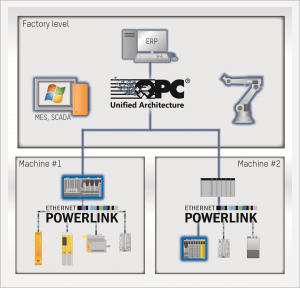OPC UA down to the sensor
Overview
Together, POWERLINK and OPC UA are integrating communication from the sensor layer to the ERP layer – without any interfaces whatsoever. The OPC Foundation and the Ethernet POWERLINK Standardization Group (EPSG) have created a companion specification which standardises the access to POWERLINK devices by OPC UA services.
Industry 4.0 and the Internet of Things (IoT) require seamless and consistent communication both within the digital factory as well as externally to cloud-based services and other Internet technologies. These requirements are now met as the EPSG and OPC Foundation have implemented a common definition for open interfaces between their Technologies.
Technical Content
In the first stage, the machine controller acts as a link between the IT-related OPC UA world and the real-time world of POWERLINK. All the machine data is mapped from the OPC UA server to the machine controller, so it is provided in a standardized way. This allows SCADA or MES systems to access sensor data, for example, without having to know anything about the inner workings of the machine.
The companion specification takes this another step further. The OPC UA protocol and the OPC UA Object Model can be fully integrated into POWERLINK devices. In its asynchronous phase – independently of the real-time data – POWERLINK is able to transmit any Ethernet protocol.
No more gateways
As a result, gateways become superfluous, because there is no need for protocol translation between the worlds of POWERLINK and IT. The machine controller doesn’t even need to know about OPC UA because it only acts as an Ethernet router. A SCADA system can take advantage of OPC UA to do things like accessing a sensor, changing parameters or retrieving diagnostic information. At the sensor/actuator level, I/O components can be used that speak both POWERLINK and OPC UA. These I/O components can send the same process and parameter data to the controller via POWERLINK and to the higher-level system via OPC UA – simultaneously and independently.
Picture: The companion specification makes it possible for the controller to provide machine data in a standardized way for use by higher-level systems (Machine #1) or for OPC UA to have direct access to sensors (Machine #2).
More Information
- The OPC UA Powerlink Companion Specification document is public available
Download here https://opcfoundation.org/developer-tools/specifications-unified-architecture/opc-ua-powerlink-companion-specification/ - See here: Video “OPC UA and Powerlink” by Stefan Bina, Marketing Powerlink
Further information can be requested through the Ethernet POWERLINK Standardization Group
http://www.ethernet-powerlink.org/.
About Ethernet POWERLINK Standardization Group (EPSG)
The Ethernet POWERLINK Standardization Group (EPSG) is an independent organization founded in 2003 by leading companies from the fields of motion control and automation technology. Its aims are the standardization and further development of the POWERLINK protocol first introduced by B&R in 2001. This high-performance real-time communication system is an advanced protocol based on the IEEE 802.3 Ethernet standard designed to ensure real-time data transfer in the microsecond range. The EPSG cooperates with leading standardization organizations such as CAN in Automation (CiA), the OPC Foundation and the IEC
Ethernet POWERLINK Standardization Group (EPSG)
POWERLINK-OFFICE
Bonsaiweg 6
15370 Fredersdorf
Germany
info@ethernet-powerlink.org
www.ethernet-powerlink.org




